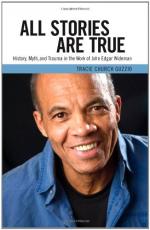|
This section contains 4,767 words (approx. 16 pages at 300 words per page) |

|
SOURCE: "'Beyond Discourse': The Unspoken Versus Words in the Fiction of John Edgar Wideman," in Callaloo, Vol. 8, No. 3, Fall, 1985, pp. 525-34.
Berben is a critic and an educator at the Université de Nice. In the following essay, she examines Wideman's use of both direct and indirect methods of communicating themes and meanings in Hiding Place.
Hiding Place, John Edgar Wideman's 1981 novel about a young black's flight from unjust accusation, reveals the ghetto experience as a honeycomb of psychological and verbal subterfuges, all temporary shelters that must eventually give way before the onslaughts of reality. Wideman shifts back and forth between the narrative devices of indirect and direct interior monologue and dialogue to juxtapose the harsh world of poverty with the realm of dreams and fantasies in which the individual can hide from the unpleasant facts of his life. Language itself is rife with "hiding places" which afford a...
|
This section contains 4,767 words (approx. 16 pages at 300 words per page) |

|


